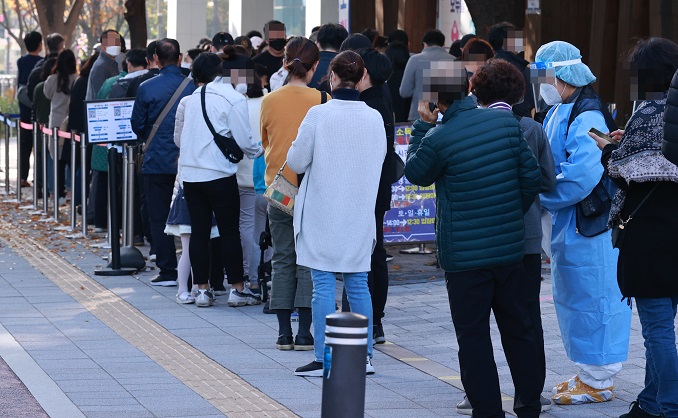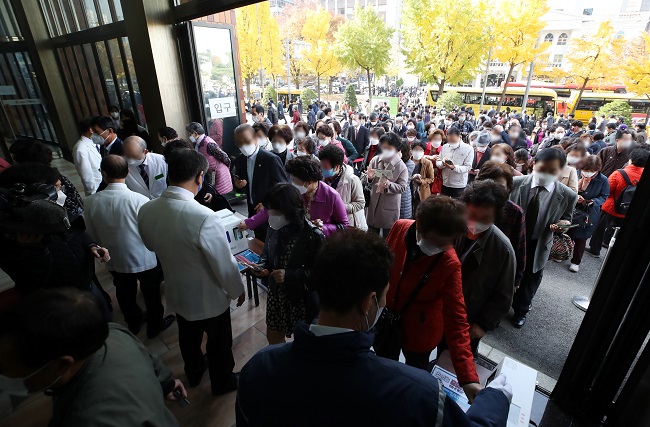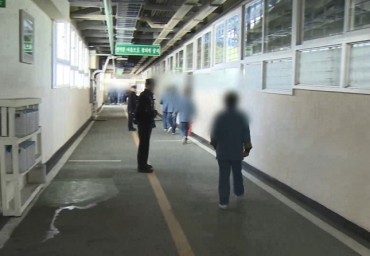
People stand in line to take coronavirus tests at a COVID-19 test center in Seoul on Nov. 7, 2021. (Yonhap)
SEOUL, Nov. 8 (Korea Bizwire) — South Korea’s new coronavirus cases fell below 2,000 for the first time in six days Monday as fewer people took virus tests over the weekend, but health authorities remain on alert as new infections could rise under eased social distancing rules.
Last week, the government began its “living with COVID-19″ scheme as part of a broader plan to gradually lift the virus restrictions by the end of February.
The country reported 1,760 new COVID-19 cases, raising the total caseload to 381,694, the Korea Disease Control and Prevention Agency (KDCA) said.
The daily caseload fell below 2,000 after reporting more than 2,000 cases for five days in a row.
Daily virus caseloads tend to decrease on weekends and holidays due to fewer virus tests.
Later in the day, health authorities and local governments reported 1,536 new cases from midnight to 9 p.m., down 85 from the same time the previous day.
The latest tally excludes cases from the country’s southeastern port city of Busan, which stopped releasing real-time data.
Of the total, 1,733 were local infections, the KDCA said. Twenty-seven cases came from overseas, putting the cumulative total at 15,270.
Of the locally transmitted cases, Seoul had 700 cases, with the surrounding Gyeonggi Province logging 538 cases and Incheon, 40 kilometers west of Seoul, 97 cases.
The death toll rose by 13 to 2,980 on Monday, the health authorities said. The fatality rate came to 0.78 percent.
The number of patients in serious or critical condition came to 409, up four from the previous day.

A church in Seoul is crowded on Nov. 7, 2021, the first weekend after South Korea shifted to its “living with COVID-19″ policy on Nov. 1. (Yonhap)
Health authorities remain on high alert as virus cases could trend back upward again under the “living with COVID-19″ scheme meant to bring the country gradually back to pre-pandemic normalcy.
On Nov. 1, South Korea kicked off the first of the three-stage “living with COVID-19″ scheme to gradually phase out coronavirus restrictions as more than 70 percent of the population have been fully vaccinated.
Under the eased rules, private gatherings of up to 10 people are allowed, regardless of vaccination. Still, wearing a face mask indoors is mandatory.
While restrictions on restaurants, cafes and movie theaters are fully lifted, high-risk facilities, such as bars and nightclubs, are required to implement the “vaccine pass” system where visitors have to show they have been fully vaccinated or have a negative test result.
Starting Monday, such facilities will be fined and penalized for violating vaccine pass guidelines. Indoor gyms will be allowed a grace period of another week to help adapt to the new measure.
Later in the day, health authorities said South Korea will introduce pills for COVID-19 treatment in February.
Earlier, the government signed a pre-purchase contract with MSD, a subsidiary of U.S. drugmaker Merck & Co., to purchase its oral COVID-19 medication for 200,000 people in September, and another deal with U.S. pharmaceutical giant Pfizer Inc. last month for 70,000 patients.
South Korea plans to secure enough oral COVID-19 medications to treat some 404,000 infected patients.
About 41.52 million people, or 80.9 percent of the country’s 52 million population, have received their first COVID-19 vaccine shots. The number of fully vaccinated people came to 39.33 million, or 76.6 percent, the KDCA said.
(Yonhap)






